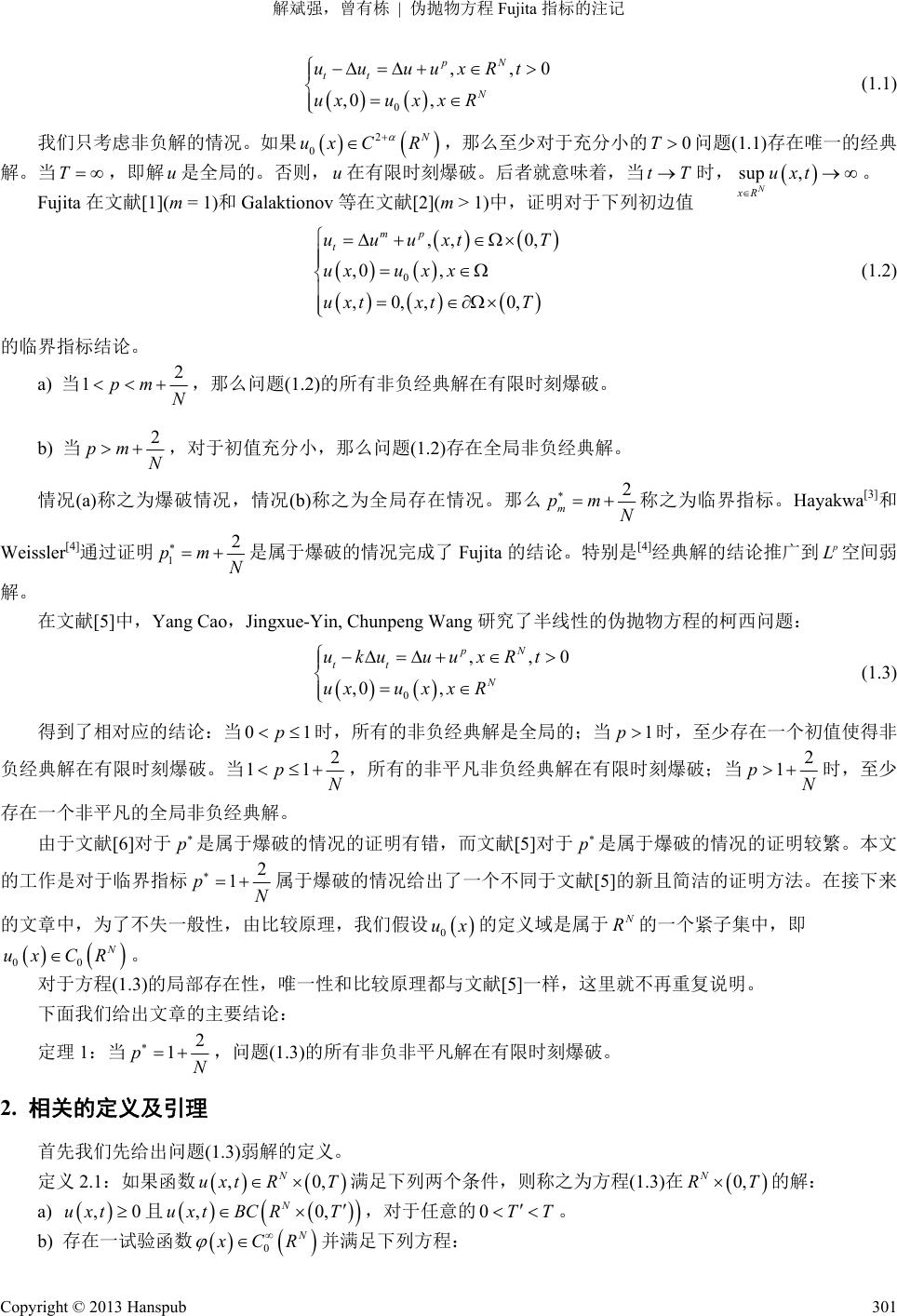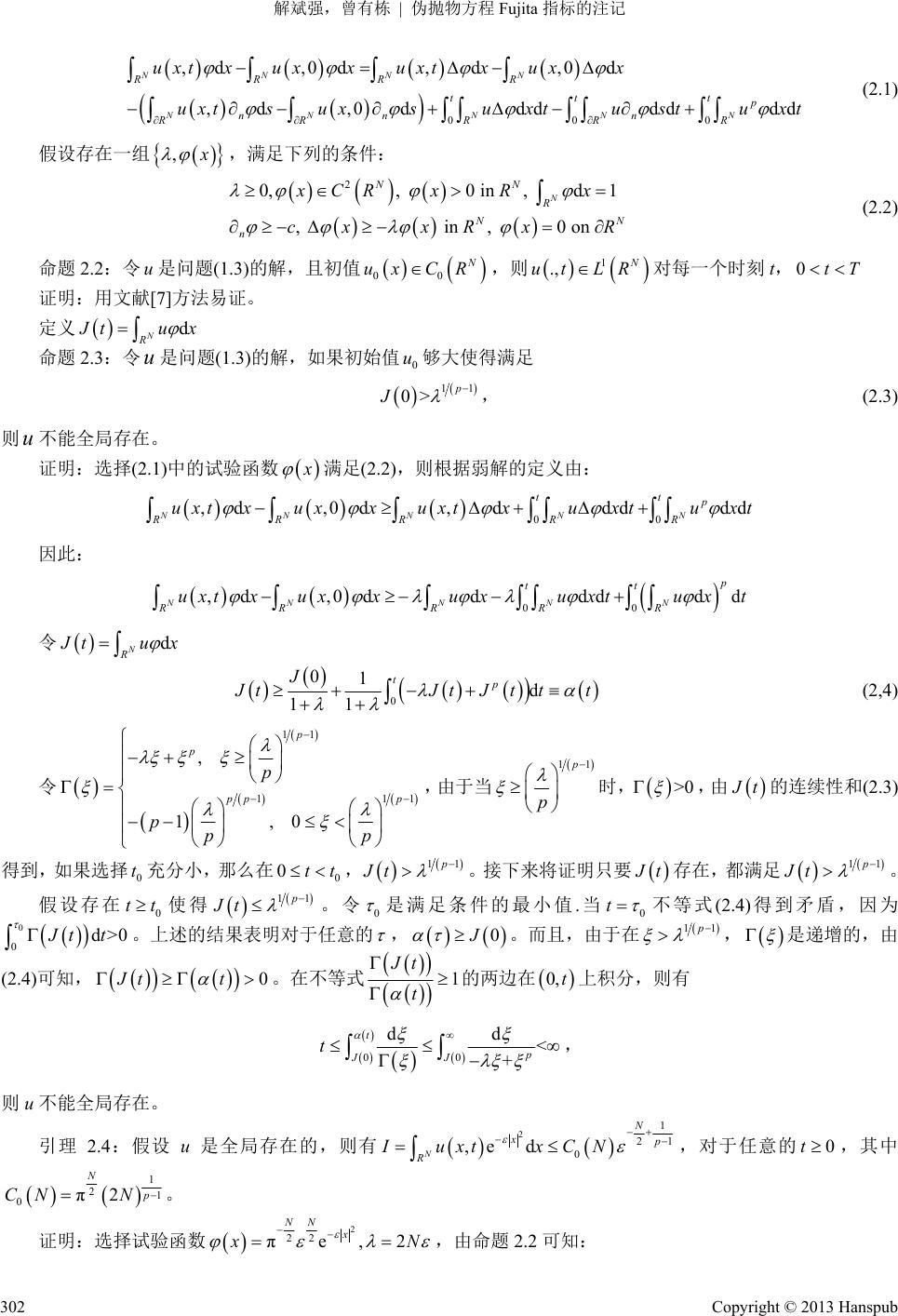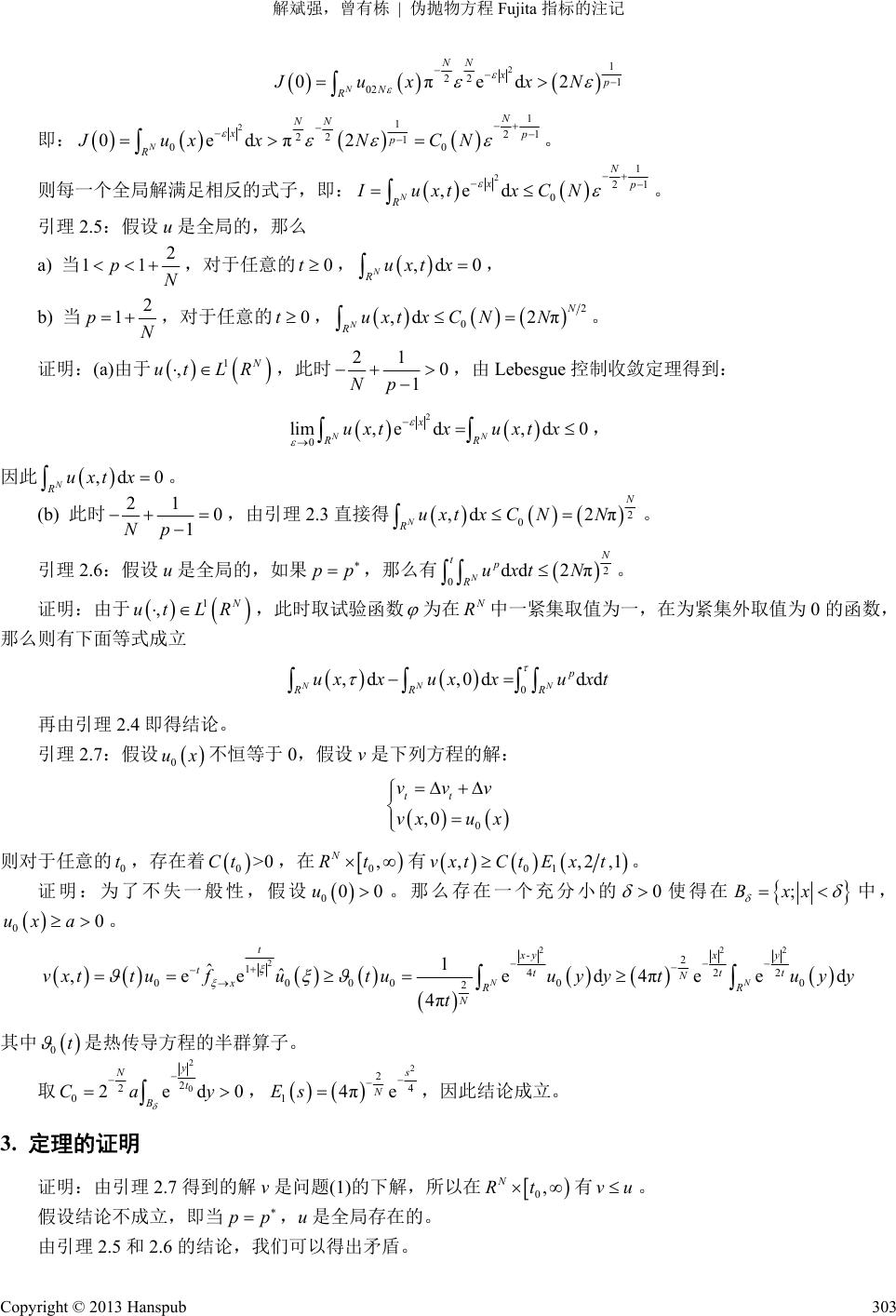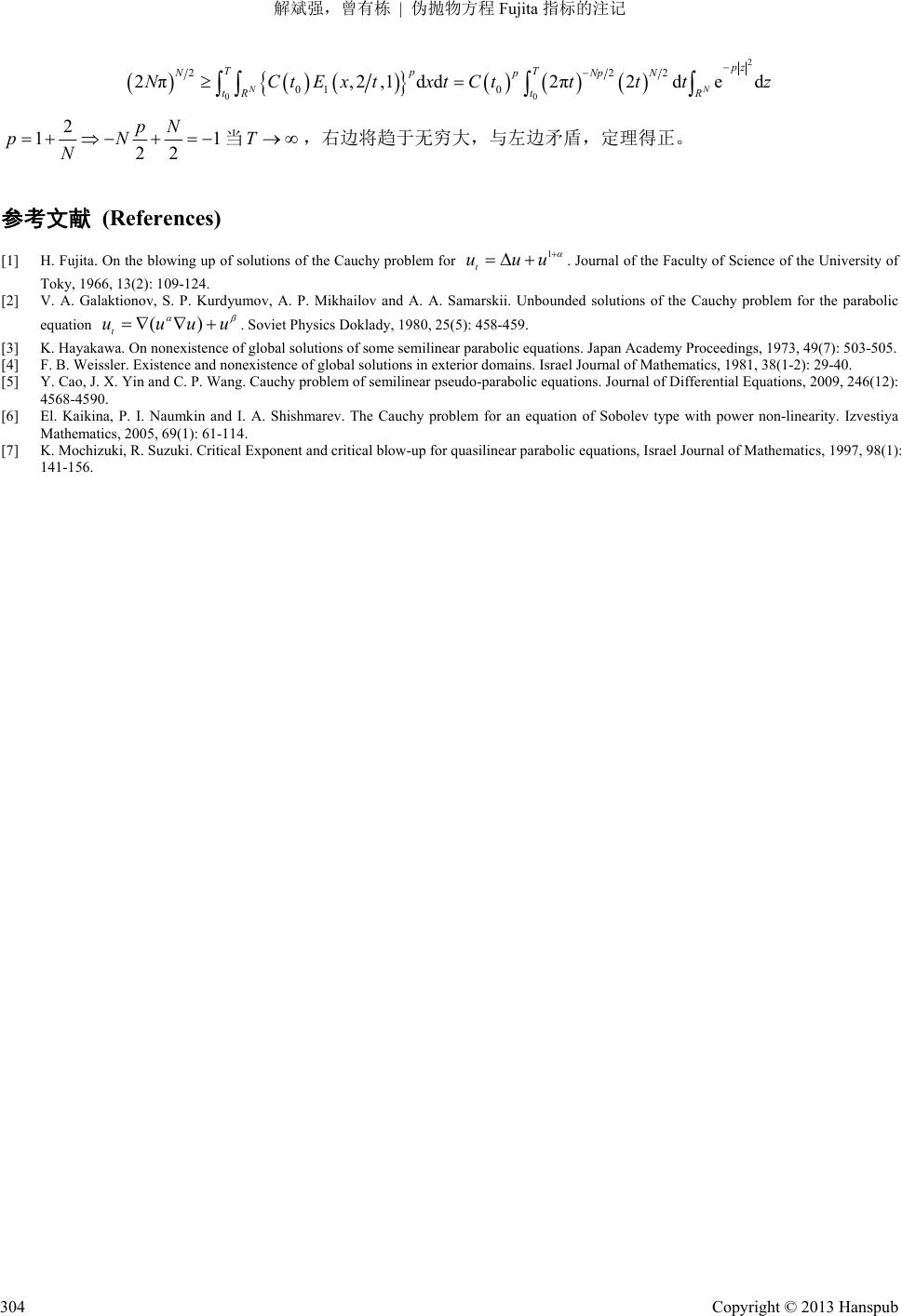 Pure Mathematics 理论数学, 2013, 3, 300-304 http://dx.doi.org/10.12677/PM.2013.35046 Published Online September 2013 (http://www.hanspub.org/journal/pm.html) The Remark about Fujita Exponent for a Pseudo-Parabolic Equation* Binqiang Xie , Yo ud ong Zeng College of Mathematics and Computer Science, Fuzhou University, Fuzhou Email: xbq211@163.com Received: Jun. 9th, 2013; revised: Jun. 28th, 2013; accepted: Jul. 8th, 2013 Copyright © 2013 Binqiang Xie, Youdong Zeng. This is an open access article distributed under the Creative Commons Attribution Li- cense, which permits unrestricted use, distribution, and reproduction in any medium, provided the original work is properly cited. Abstract: In this paper we consider nonnegative solutions to the Cauchy problem for the pseudo-parabolic equation p tt uuuu . It is well known that 2 1pN is the critical exponent of blow up. Namely, if , then all the nontrivial solutions blow up in finite time (blow-up case), and if , then there are nontrivial global solutions (global existence case). In this paper we show for the Cauchy problem, pp pp p belongs to the blow-up case. Because [6], there is something wrong in the proof for belonging to the blow-up case, while [5] the method is too complicate. In the paper we give a new simpler proof for the critical exponent p 2 1pN which belongs to the blow-up case, moreover we generalize classical solution to the general weak solution case. Keywords: Pseudo-Parabolic; Cauchy Problem; Blow-Up; Fujita Exponent 伪抛物方程 Fujita 指标的注记* 解斌强,曾有栋 福州大学,数学与计算机科学学院,福州 Email: xbq211@163.com 收稿日期:2013 年6月9日;修回日期:2013年6月28 日;录用日期:2013 年7月8日 摘 要:本文考虑伪抛物方程 p tt uuuu 的柯西问题的非负解。对于柯西问题,已经知道 2 1pN 是爆破的临界指标;即当 pp ,所有的非负非平凡解在有限时刻爆破(爆破情况),当 pp 时,存在着非平凡的全局解(全局存在情况)。由于文献[6]对于 p 是属于爆破的情况的证明有错,而文 献[5]对于 是属于经典解的爆破的情况的证明较繁。本文是对于临界指标 p2 1pN 属于爆破的情况 给出了一个新且简洁的证明方法且经典解推广到更为一般的弱解。 关键词:伪抛物;柯西问题;爆破;Fujita 指标 1. 引言 在本文中,我们将考虑的是下列伪抛物的柯西问题 *基金项目:福建省自然科学基金项目 Z0511015。 Copyright © 2013 Hanspub 300  解斌强,曾有栋 伪抛物方程 Fujita 指标的注记 0 ,, ,0 , pN tt N uuuuxRt uxux xR 0 (1.1) 我们只考虑非负解的情况。如果 2 0 N ux CR u ,那么至少对于充分小的 问题(1.1)存在唯一的经典 解。当T,即解 是全局的。否则, 在有限时刻爆破。后者就意味着,当时,。 0T tT u sup , N xR uxt Fujita 在文献[1](m = 1)和Galaktionov 等在文献[2](m > 1)中,证明对于下列初边值 0 ,, 0, ,0 , ,0,, 0, mp t uuuxt T uxux x uxt xtT (1.2) 的临界指标结论。 a) 当2 1pmN ,那么问题(1.2)的所有非负经典解在有限时刻爆破。 b) 当2 pmN ,对于初值充分小,那么问题(1.2)存在全局非负经典解。 情况(a)称之为爆破情况,情况(b)称之为全局存在情况。那么 2 m pm N 称之为临界指标。Hayakwa[3]和 Weissler[4]通过证明1 2 pm N 是属于爆破的情况完成了 Fujita 的结论。特别是[4]经典解的结论推广到 p L空间弱 解。 在文献[5]中,Yang Cao,Jingxue-Yin, Chunpeng Wang 研究了半线性的伪抛物方程的柯西问题: 0 ,, ,0 , pN tt N uku uuxRt uxux xR 0 1 (1.3) 得到了相对应的结论:当时,所有的非负经典解是全局的;当 时,至少存在一个初值使得非 0p 1p 负经典解在有限时刻爆破。当 2 11 pN ,所有的非平凡非负经典解在有限时刻爆破;当 2 1 pN 时,至少 存在一个非平凡的全局非负经典解。 由于文献[6]对于 是属于爆破的情况的证明有错,而文献[5]对于pp 是属于爆破的情况的证明较繁。本文 的工作是对于临界指标 2 1 pN 属于爆破的情况给出了一个不同于文献[5]的新且简洁的证明方法。在接下来 的文章中,为了不失一般性,由比较原理,我们假设 0 ux 的定义域是属于 N R的一个紧子集中,即 。 00 N ux CR 对于方程(1.3)的局部存在性,唯一性和比较原理都与文献[5]一样,这里就不再重复说明。 下面我们给出文章的主要结论: 定理 1:当 2 1 pN ,问题(1.3)的所有非负非平凡解在有限时刻爆破。 2. 相关的定义及引理 首先我们先给出问题(1.3)弱解的定义。 定义 2.1:如果函数 满足下列两个条件,则称之为方程(1.3)在 的解: , N uxt RT N 0, T 0, 0, N R a) 且ux ,对于任意的 ,0uxt ,t BCRT 0TT 。 b) 存在一试验函数 0 N x CR 并满足下列方程: Copyright © 2013 Hanspub 301  解斌强,曾有栋 伪抛物方程 Fujita 指标的注记 00 0 ,d ,0d,d ,0d ,d ,0dddddd NN NN NN NNN RR RR tt t p nn n RR RRR uxtx uxxuxtx uxx uxtsuxsuxtustuxt d (2.1) 假设存在一组 , x ,满足下列的条件: 2 0,, 0 in , d1 , in , 0on N NN R N N n xCR xRx cx xRxR (2.2) 命题 2.2:令 是问题(1.3)的解,且初值u 00 N ux CR,则 1 ., N ut LR对每一个时刻t,0 tT 证明:用文献[7]方法易证。 定义 d N R J tux 命题 2.3:令 是问题(1.3)的解,如果初始值 够大使得满足 u0 u 11 0> p J , (2.3) 则 不能全局存在。 u 证明:选择(2.1)中的试验函数 x 满足(2.2),则根据弱解的定义由: 00 ,d,0d,ddddd NN NNN tt p RRR RR uxtxuxxuxtxuxtu xt 因此: 00 ,d ,0dddddd NN NNN p tt RR RRR uxtxuxxu xuxtu xt 令 d N R J tux 0 01d 11 tp J J tJtJt tt (2,4) 令 11 11 , 1, 0 p p pp p p ppp 1 ,由于当 11p p 时, >0 ,由 J t的连续性和(2.3) 得到,如果选择 充分小,那么在, 0 t0 0tt 11p Jt 。接下来将证明只要 J t存在,都满足 11p Jt 。 假设存在 使得 0 tt 11p Jt 。令0 是满足条件的最小值.当0 t 不等式(2.4) 得到矛盾,因为 0 0d>0 J tt 。上述的结果表明对于任意的 , 0J 。而且,由于在 11p , 是递增的,由 (2.4)可知, 。在不等式 0Jt t 1 Jt t 的两边在 0, t上积分,则有 00 dd < + t p JJ t , 则u不能全局存在。 引理 2.4:假设 u是全局存在 的,则有 21 2 0 ,e d N N xp R Iuxt xCN 1 ,对于任意的 ,其中0t 1 21 0π2 N p CN N 。 证明:选择试验函数 2 22 πe,2 NN x x N ,由命题2.2 可知: Copyright © 2013 Hanspub 302  解斌强,曾有栋 伪抛物方程 Fujita 指标的注记 21 22 1 02 0πed 2 N NN xp N R JuxxN 即: 21 12 22 1 00 0edπ2 N N NN x1 p p R Juxx NCN 。 则每一个全局解满足相反的式子,即: 21 2 0 ,e d N N xp R Iuxt xCN 1 。 引理 2.5:假设 u是全局的,那么 a) 当2 11pN ,对于任意的 ,0t ,d0 N Ruxt x , b) 当2 1pN ,对于任意的 ,0t 2 0 ,d 2π N N RuxtxC NN 。 证明:(a)由于 1 ,N ut LR ,此时 210 1Np ,由 Lebesgue 控制收敛定理得到: 2 0 lim, ed, d0 NN x RR uxtxuxt x , 因此 。 ,d0 N Ruxt x (b) 此时 210 1Np ,由引理 2.3 直接得 2 0 ,d 2π N N Ruxtx C NN 。 引理 2.6:假设 u是全局的,如果 pp ,那么有 2 0dd2 π N N tp Ruxt N 。 证明:由于 ,此时取试验函数 1 ,N ut LR 为在 N R中一紧集取值为一,在为紧集外取值为 0的函数, 那么则有下面等式成立 0 ,d ,0ddd NN N p RR R uxxuxxu xt 再由引理2.4 即得结论。 引理 2.7:假设不恒等于 0,假设 v是下列方程的解: 0 ux 0 ,0 tt vvv vxu x 则对于任意的 ,存在着 0 t 0>0Ct ,在 0, N Rt有 01 ,,vxtCtExt2,1 。 证明:为了不失一般性,假设 。那么存在一个充分小的 000u0 使得在 ;Bxx 中, 。 00uxa 22 2-2 142 0000 0 2 1 ˆˆ ,ee ed4πee 4π NN txyx y ttt N xRR N vxttufutuuyy tuyy t 2 2 0 d t 其中 是热传导方程的半群算子。 0t 取 2 0 2 2 0 2ed0 y Nt B Ca y , 2 2 4 14πe s N Es ,因此结论成立。 3. 定理的证明 证明:由引理2.7 得到的解 v是问题(1)的下解,所以在 0, N Rt 有vu 。 假设结论不成立,即当 ,u是全局存在的。 pp 由引理 2.5 和2.6 的结论,我们可以得出矛盾。 Copyright © 2013 Hanspub 303  解斌强,曾有栋 伪抛物方程 Fujita 指标的注记 Copyright © 2013 Hanspub 304 2 0 0 222 01 0 2π,2,1d d2π2ded N N pz TT pp NNp N tRt R NCtExtxtCtttt z 2 11 22 pN pN N 当T,右边将趋于无穷大,与左边矛盾,定理得正。 参考文献 (References) [1] H. Fujita. On the blowing up of solutions of the Cauchy problem for 1 t uuu . Journal of the Faculty of Science of the University of Toky, 1966, 13(2): 109-124. [2] V. A. Galaktionov, S. P. Kurdyumov, A. P. Mikhailov and A. A. Samarskii. Unbounded solutions of the Cauchy problem for the parabolic equation u() t uuu . Soviet Physics Doklady, 1980, 25(5): 458-459. [3] K. Hayakawa. On nonexistence of global solutions of some semilinear parabolic equations. Japan Academy Proceedings, 1973, 49(7): 503-505. [4] F. B. Weissler. Existence and nonexistence of global solutions in exterior domains. Israel Journal of Mathematics, 1981, 38(1-2): 29-40. [5] Y. Cao, J. X. Yin and C. P. Wang. Cauchy problem of semilinear pseudo-parabolic equations. Journal of Differential Equations, 2009, 246(12): 4568-4590. [6] El. Kaikina, P. I. Naumkin and I. A. Shishmarev. The Cauchy problem for an equation of Sobolev type with power non-linearity. Izvestiya Mathematics, 2005, 69(1): 61-114. [7] K. Mochizuki, R. Suzuki. Critical Exponent and critical blow-up for quasilinear parabolic equations, Israel Journal of Mathematics, 1997, 98(1): 141-156. |